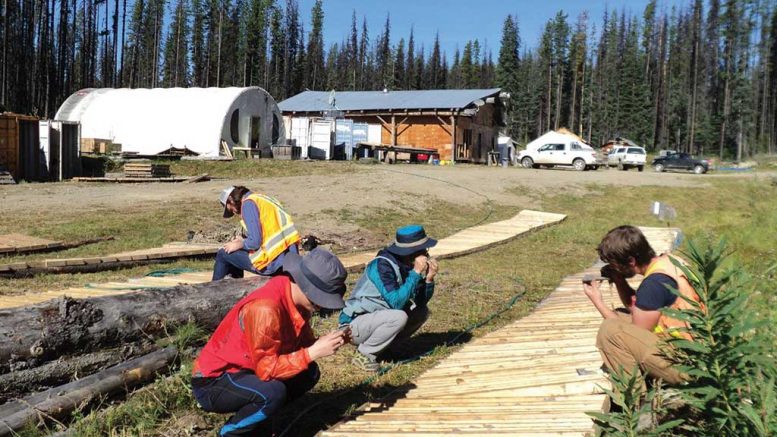VANCOUVER — Underground and open-pit mining at Serengeti Resources’ (TSXV: SIR) Kwanika copper-gold property, 250 km east of Smithers, B.C., could boost the project’s economics, according to the company’s new preliminary economic assessment (PEA).
The study envisages a 15,000-tonne-per-day operation over a 15-year mine life, with the first nine years focused on block-cave mining the project’s high-grade, copper-gold Central zone porphyry deposit, before switching to open-pit mining at the lower-grade South zone, 2 km south.
The mining scenario delivers a $324.4-million pre-tax net present value (NPV) at a 7% discount rate, and a 21.1% pre-tax internal rate of return (IRR), and would give a 3.7-year payback on $476 million in capital costs.

General location map of Serengeti’s Kwanika copper-gold property in B.C. Credit: Serengeti Resources.
The results are better than the company’s 2013 PEA, which calculated a pre-tax NPV of $143.3 million at an 8% discount rate, a 13.4% pre-tax IRR, and a 7.3-year payback from a 13.5-year open-pit operation.
David Moore, president and CEO of Serengeti, tells The Northern Miner during a phone interview that the economics incorporate an updated, geologically constrained resource model — published by SRK Consulting in November last year — that increased precious metal grades by 20%.
“We’ll start with an open-pit on part of the Central and go as quickly as we can underground, so we can access the higher grades,” he says. “It’s a gold-rich system. So what we’ve done is come up with a much better production schedule, and that has made a big difference on the project’s economics.”
He adds that over 64% of the revenue in the project’s first eight years is due to gold and silver credits.
Pit-constrained resources for the Central zone stand at 101.5 million indicated tonnes of 0.31% copper, 0.32 gram gold per tonne and 0.96 gram silver per tonne, and 31.9 million inferred tonnes of 0.17% copper, 0.14 gram gold and 0.59 gram silver.
Underground resources add 29.7 million indicated tonnes of 0.34% copper, 0.36 gram gold and 1.05 grams silver, and 7.9 million inferred tonnes of 0.23% copper, 0.17 gram gold and 0.68 gram silver.
Open-pit resources from the South zone are 33.3 million inferred tonnes of 0.26% copper, 0.08 gram gold, 1.64 grams silver and 0.01% molybdenum.

Drillers on hole 179, which extended deeply, northwest of the Central zone at Serengeti Resources’ Kwanika copper-gold project. Credit: Serengeti Resources.
Daewoo’s opportunity
Serengeti is advancing the project alongside 5% partner Daewoo Minerals Canada — a subsidiary of one of South Korea’s leading trading companies Posco Daewoo — as part of a deal signed in April last year.
Daewoo earned its current interest by paying Serengeti $400,000 in cash and spending $800,000 in exploration on the project last year.
Moore says that within 90 days of filing the PEA report on Sedar, Daewoo is required to decide whether or not the company will pay Serengeti $7 million over the next two years to earn another 30% interest in the project.
“The economics are in the sweet spot of what Daewoo would be interested in,” he says. “Their $7-million investment could give them $55-million worth of value in the project, so we’re pretty confident they’ll move forward.”
A $7-million capital injection could facilitate a “significant” drill program by September, Moore says. The program would convert inferred resources to indicated, increase the gold grade at the Central zone and push the boundaries on the resource limits.
“Gold grades have great implications on our economics, so if we can drill more holes and continue that trend, we can add a lot of value to the project quickly,” he says.
As reported in “Upside ‘very much alive’ at Kwanika in BC” (T.N.M., Sept. 28/16), a part of Serengeti’s drill program last year aimed for a deeply buried induced polarization chargeability anomaly. The anomaly suggested that mineralization at the Central zone could extend up to 1 km north below prior drilling, giving Kwanika more room to grow.
The hole hit 245 metres of 0.1% copper and 0.11 gram gold before it was crosscut with a fault and a post-mineral intrusive. Moore says that the hole skirted over the strongest part of the anomaly, and drill programs would follow up.
Shares of Serengeti have traded within a 52-week range between 4¢ and 33¢, and closed at 15¢ at press time. The company has 71.5 million shares outstanding for an $11.9-million market capitalization.


Be the first to comment on "Serengeti sees potential underground at Kwanika"